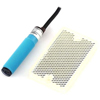What are the Types of Photoelectric Sensors?
A photoelectric sensor is a device that converts optical signals into electrical signals. Its working principle is based on the photoelectric effect. The photoelectric effect refers to the phenomenon of the corresponding electrical effect occurring when the electrons of the material absorb the energy of photons when light is irradiated on certain substances. According to the difference of photoelectric effect phenomenon, photoelectric effect is divided into three categories: external photoelectric effect, internal photoelectric effect and photovoltaic effect. Photoelectric devices include photocells, photomultipliers, photoresistors, photodiodes, phototransistors, and photocells. The performance and characteristic curves of optoelectronic devices were analyzed. So, what are the types of photoelectric sensors?
- Slot type photoelectric sensor
- Through beam photoelectric sensor
- Retro-reflective photoelectric sensor
- Diffuse reflective photoelectric sensor
Slot type photoelectric sensor
 It is a slot optoelectronic device that installs an optical transmitter and a receiver face-to-face on both sides of a slot. The light emitter can emit infrared light or visible light, and the light receiver can receive the light without obstruction. However, when the detected object passes through the slot, the light is blocked, and the photoelectric switch operates. Output a switch control signal to cut off or turn on the load current to complete a control action. The detection distance of the slot switch is generally only a few centimeters due to the limitation of the overall structure.
It is a slot optoelectronic device that installs an optical transmitter and a receiver face-to-face on both sides of a slot. The light emitter can emit infrared light or visible light, and the light receiver can receive the light without obstruction. However, when the detected object passes through the slot, the light is blocked, and the photoelectric switch operates. Output a switch control signal to cut off or turn on the load current to complete a control action. The detection distance of the slot switch is generally only a few centimeters due to the limitation of the overall structure.
Through beam photoelectric sensor
 If the emitter and receiver are separated, the detection distance can be increased. A photoelectric switch composed of a light emitter and a light receiver is called an opposite-beam split photoelectric switch, or an opposite-beam photoelectric switch for short. Its detection distance can reach several meters or even tens of meters. When in use, the light-emitting device and the light-receiving device are respectively installed on both sides of the passing path of the detection object. When the detection object passes through, the light path is blocked, and the light-receiving device acts to output a switch control signal.
If the emitter and receiver are separated, the detection distance can be increased. A photoelectric switch composed of a light emitter and a light receiver is called an opposite-beam split photoelectric switch, or an opposite-beam photoelectric switch for short. Its detection distance can reach several meters or even tens of meters. When in use, the light-emitting device and the light-receiving device are respectively installed on both sides of the passing path of the detection object. When the detection object passes through, the light path is blocked, and the light-receiving device acts to output a switch control signal.
Retro-reflective photoelectric sensor
 The light-emitting device and the light-receiving device are installed in the same device, and a reflector is installed in front of it. The photoelectric switch that uses the reflection principle to complete the photoelectric control function is called a reflector reflection (or mirror reflection) photoelectric switch. Under normal circumstances, the light emitted by the emitter is reflected by the reflector and received by the receiver; once the optical path is blocked by the detection object and the receiver cannot receive light, the photoelectric switch will act and output a switch control signal.
The light-emitting device and the light-receiving device are installed in the same device, and a reflector is installed in front of it. The photoelectric switch that uses the reflection principle to complete the photoelectric control function is called a reflector reflection (or mirror reflection) photoelectric switch. Under normal circumstances, the light emitted by the emitter is reflected by the reflector and received by the receiver; once the optical path is blocked by the detection object and the receiver cannot receive light, the photoelectric switch will act and output a switch control signal.
Diffuse reflective photoelectric sensor
 It also has a light emitter and a light receiver in its detection head, but there is no reflector in front. Under normal circumstances, the light-receiver emitted by the emitter cannot be found. When the detection object passes through, it blocks the light and partially reflects the light back, and the light receiver receives the light signal and outputs a switch signal.
It also has a light emitter and a light receiver in its detection head, but there is no reflector in front. Under normal circumstances, the light-receiver emitted by the emitter cannot be found. When the detection object passes through, it blocks the light and partially reflects the light back, and the light receiver receives the light signal and outputs a switch signal.

